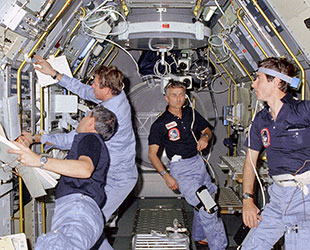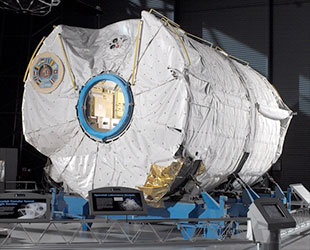November 29, 2013 — It doesn't seem out of place today, but the sight 30 years ago of a cylindrical module mounted inside the space shuttle's cargo bay was described as an "odd-appearing assemblage" in 1983.
The unusual payload was Spacelab, a $1 billion European built, NASA-operated space-borne science platform, which would not only set the stage for investigations onboard the space shuttle, but would lay the foundation for major parts of today's International Space Station.
Space shuttle Columbia launched on Nov. 28, 1983, lifting into orbit the Spacelab and six astronauts. Under the lead of commander John Young, the STS-9 crew included pilot Brewster Shaw and mission specialists Owen Garriott and Robert Parker.
Rounding out Columbia's crew were the shuttle program's first payload specialists, Byron Lichtenberg and the first European to fly on a NASA mission, Ulf Merbold.

Composite image of space shuttle Columbia with the Spacelab 1 module exposed in the cargo bay. (NASA/RetroSpaceImages.com) |
The ten-day mission didn't fly to the moon, as Young had done twice, or crew a space station, as Garriott had ten years earlier aboard the Skylab orbital workshop, but it did establish the first short-duration crewed science laboratory to orbit the Earth.
"The knowledge Spacelab will bring back from its many missions will belong to all mankind," then-Vice President George H.W. Bush declared at a 1982 ceremony marking the delivery of the Spacelab to Kennedy Space Center in Florida.
Ten years, ten countries
Dwarfed today by the engineering accomplishment that is the International Space Station, Spacelab was at the time of its first launch "the culmination of history's largest and most comprehensive multinational space project," Walter Froehlich wrote in the NASA publication "Spacelab" prior to the STS-9 mission.
Ten years in the making, Spacelab was the product of ten countries — Austria, Belgium, Denmark, France, (West) Germany, Italy, the Netherlands, Spain, Switzerland and the United Kingdom, all members of the European Space Agency (ESA). Together, the countries were responsible for funding, designing and building Spacelab, as well as delivering an engineering model, the first flight module and ground support equipment. In return, NASA invited ESA to join in flying on Columbia's mission.

STS-9 crew members working on science experiments inside the European Spacelab 1 module. (NASA/RetroSpaceImages.com) |
German astronaut Ulf Merbold and his STS-9 crewmates split into two teams, each working 12-hour operating the Spacelab's 70 science experiments dedicated to solar and space plasma physics, material science, technology and life sciences, astronomy and Earth observations.
Designed to be reusable, Spacehab comprised more than just a laboratory module. Unpressurized (or open) pallets were also flown, on which science instruments, including telescopes, were mounted.
Two 13.5-foot diameter (4-meter) cylindrical modules were launched on 16 shuttle missions between 1983 and 1998, logging 244 days in orbit. More than 10 Spacelab pallets were also carried into space, with the last flight in 2008.
Spacelab's legacy
Today, the Spacelab module that first flew on Columbia in 1983 is displayed by the Smithsonian at the National Air and Space Museum Steven F. Udvar-Hazy Center located outside Washington, D.C. The second module is located at Bremen Airport in Germany.

The first Spacelab module flown in space, as seen on display at the Steven F. Udvar-Hazy Center, Virginia. (NASM/Dane Penland) |
Spacelab's legacy however, is represented by more than just museum exhibits.
In addition to making possible the first dedicated German and Japanese missions (D1, D2 and Spacelab-J shuttle flights in 1985, 1993 and 1992, respectively), the concept of a pressurized module in the payload bay gave rise to the commercial SPACEHAB and later the Multi-Purpose Logistic Modules, which flew on the shuttle as well.
Further, Spacelab's pressure shell design was reused for the "Harmony" and "Tranquility" nodes on the International Space Station, and supply spacecraft, including Europe's Automated Transfer Vehicles (ATV) and Orbital Sciences' commercial Cygnus, have adapted the Spacelab's exterior structure, according to the European Space Agency.
ESA's Columbus laboratory, Europe's primary contribution to the space station, also evolved from Spacelab as were the module's standardized science racks, which now line all of the station's lab modules.
